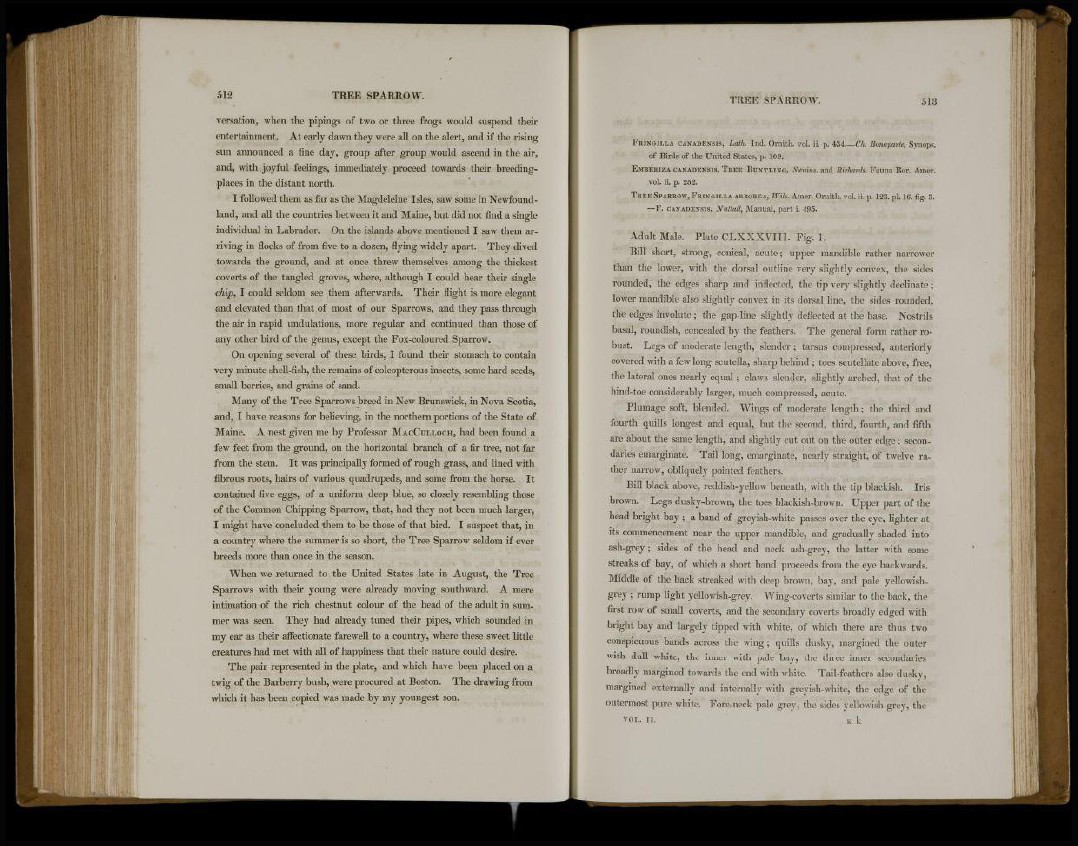
512 TREE SPARROW.
versation, when the pipings of two or three frogs would suspend their
entertainment. At early dawn they were all on the alert, and if the rising
sun announced a fine day, group after group would ascend in the air,
and, with joyful feelings, immediately proceed towards their breedingplaces
in the distant north.
I followed them as far as the Magdeleine Isles, saw some in Newfoundland,
and all the countries between it and Maine, but did not find a single
individual in Labrador. On the islands above mentioned I saw them arriving
in flocks of from five to a dozen, flying widely apart. They dived
towards the ground, and at once threw themselves among the thickest
coverts of the tangled groves, where, although I could hear their single
chip, I could seldom see them afterwards. Their flight is more elegant
and elevated than that of most of our Sparrows, and they pass through
the air in rapid undulations, more regular and continued than those of
any other bird of the genus, except the Fox-coloured Sparrow.
On opening several of these birds, I found their stomach to contain
very minute shell-fish, the remains of coleopterous insects, some hard seeds,
small berries, and grains of sand.
Many of the Tree Sparrows breed in New Brunswick, in Nova Scotia,
and, I have reasons for believing, in the northern portions of the State of
Maine. A nest given me by Professor MACCULLOCH, had been found a
few feet from the ground, on the horizontal branch of a fir tree, not far
from the stem. It was principally formed of rough grass, and lined with
fibrous roots, hairs of various quadrupeds, and some from the horse. It
contained five eggs, of a uniform deep blue, so closely resembling those
of the Common Chipping Sparrow, that, had they not been much larger,
I might have concluded them to be those of that bird. I suspect that, in
a country where the summer is so short, the Tree Sparrow seldom if ever
breeds more than once in the season.
When we returned to the United States late in August, the Tree
Sparrows with their young were already moving southward. A mere
intimation of the rich chestnut colour of the head of the adult in summer
was seen. They had already tuned their pipes, which sounded in
my ear as their affectionate farewell to a country, where these sweet little
creatures had met with all of happiness that their nature could desire.
The pair represented in the plate, and which have been placed on a
twig of the Barberry bush, were procured at Boston. The drawing from
which it has been copied was made by my youngest son.
TREE SPARROW. 5 1 3
FRINGILLA CANADENSIS, Lath. Ind. Ornith. vol. ii. p. 434—Ch. Bonaparte, Synops.
of Birds of the United States, p. 109.
EMEERIZA CANADENSIS, TREE BUNTLING, Swains, and Richards. Fauna Bor. Amer.
vol. ii. p. 252.
TREE SPARROW, FRINGILLA ARROREA, Wits. Amer. Ornith. vol. ii. p. 123. pi. 16. fig. 3 .
—F. CANADENSIS. Nuttall, Manual, part i. 495.
Adult Male. Plate CLXXXVIII. Fig. 1.
Bill short, strong, conical, acute; upper mandible rather narrower
than the lower, with the dorsal outline very slightly convex, the sides
rounded, the edges sharp and inflected, the tip very slightly decimate;
lower mandible also slightly convex in its dorsal line, the sides rounded,
the edges involute ; the gap-line slightly deflected at the base. Nostrils
basal, roundish, concealed by the feathers. The general form rather robust.
Legs of moderate length, slender; tarsus compressed, anteriorly
covered with a few long scutella, sharp behind ; toes scutellate above, free,
the lateral ones nearly equal; claws slender, slightly arched, that of the
hind-toe considerably larger, much compressed, acute.
Plumage soft, blended. Wings of moderate length; the third and
fourth quills longest and equal, but the second, third, fourth, and fifth
are about the same length, and slightly cut out on the outer edge; secondaries
emarginate. Tail long, emarginate, nearly straight, of twelve rather
narrow, obliquely pointed feathers.
Bill black above, reddish-yellow beneath, with the tip blackish. Iris
brown. Legs dusky-brown, the toes blackish-brown. Upper part of the
head bright bay ; a band of greyish-white passes over the eye, lighter at
its commencement near the upper mandible, and gradually shaded into
ash-grey ; sides of the head and neck ash-grey, the latter with some
streaks of bay, of which a short band proceeds from the eye backwards.
Middle of the back streaked with deep brown, bay, and pale yellowishgrey
; rump light yellowish-grey. Wing-coverts similar to the back, the
first row of small coverts, and the secondary coverts broadly edged with
bright bay and largely tipped with white, of which there are thus two
conspicuous bands across the wing; quills dusky, margined the outer
with dull white, the inner with pale bay, the three inner secondaries
broadly margined towards the end with white. Tail-feathers also dusky,
margined externally and internally with greyish-white, the edge of the
outermost pure white. Fore-neck pale grey, the sides yellowish grey, the
VOL. II. K k